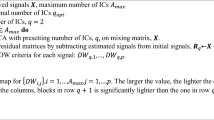Abstract
Current approaches for blind source separation, such as independent component analysis (ICA), implicitly assume that the number of collected signals equals the number of sources. This assumption does not hold true in many real-world applications as in the case of electroencephalographic (EEG) data collected from the surface of a human’s scalp, where independent EEG information is mixed with independent artifacts. This situation is abstracted in this paper by introducing the singers’ party problem, where the number of signals collected from the party equals the number of singers. However, there are also a number of instruments playing at the party representing independent sources that need to be removed correctly to extract the voices of the singers. In this paper, we introduce a decompositional approach to project the sources found in ICA into a higher-dimensional space; providing the ability to separate local (singers) information from shared/global (instruments) information. The decomposition will also associate each component with a mixed signal, creating a bijective relationship between the mixed signals and the sources. The problem is formulated as a multi-objective optimization problem. We compare the pros and cons of two different multi-objective formulations of the problem and demonstrate that one of the formulations can effectively solve the singers party problem.













Similar content being viewed by others
Explore related subjects
Discover the latest articles, news and stories from top researchers in related subjects.References
Abbass H (2014) Calibrating independent component analysis for real-time EEG artifacts removal. Lecture Notes Computer Science (LNCS) 8836:6875
Abbass H, Tang J, Amin R, Ellejmi M, Kirby S (2014b) The computational air traffic control brain: computational red teaming and big data for real-time seamless brain-traffic integration. J Air Traffic Control 56(2):10–17
Abbass H, Tang J, Amin R, Ellejmi M, Kirby S (2014) Augmented cognition using real-time EEG-based adaptive strategies for air traffic control. In: International Annual Meeting of the Human Factors and Ergonomic Society, HFES, SAGE
Bell AJ, Sejnowski TJ (1995) An information-maximization approach to blind separation and blind deconvolution. Neural Comput 7:1129–1159
Belouchrani A, Abed-Meraim K, Cardoso JF, Moulines E (1997) A blind source separation technique using second-order statistics. IEEE Trans Signal Process 45:434–444
Deb K et al (2002) A fast and elitist multiobjective genetic algorithm: NSGA-II. Evol Comput, IEEE Trans 6(2):182–197
Delorme A, Plamer J, Oostenveld R, Onton J, Makeig S (2007) Comparing results of algorithms implementing blind source separation of EEG data. Swartz Foundation and NIH Grant
Goh SK, Abbass HA, Tan KC (2014) Artifact removal from eeg using a multi-objective independent component analysis model. Lecture Notes Computer Science (LNCS) 8834:570577
Hyvärinen A, Oja E (2000) Independent component analysis: algorithms and applications. Neural Netw 13(4):411–430
Jung TP, Makeig S, Humphries C, Lee TW, Mckeown MJ, Iragui V, Sejnowski TJ (2000) Removing electroencephalographic artifacts by blind source separation. Psychophysiology 37(02):163–178
Makeig S, Westerfield M, Jung TP, Enghoff S, Townsend J, Courchesne E, Sejnowski TJ (2002) Dynamic brain sources of visual evoked responses. Science 295(5555):690–694
Vigário R (1997) Extraction of ocular artefacts from EEG using independent component analysis. Electroencephalogr Clin Neurophysiol 103(3):395–404
Vigário R, Jousmäki V, Hämäläninen M, Hari R, Oja E (1998) Independent component analysis for identification of artifacts in magnetoencephalographic recordings. Adv Neural Inf Process Syst 229–235
Acknowledgments
The second author acknowledges funding from the University of New South Wales, Australia, that allowed him the time to conduct this work in Singapore. This work was also supported by the Singapore Ministry of Education Academic Research Fund Tier 1 under the project R-263-000-A12-112.
Author information
Authors and Affiliations
Corresponding author
Additional information
Communicated by V. Loia.
Rights and permissions
About this article
Cite this article
Goh, S.K., Abbass, H.A., Tan, K.C. et al. Decompositional independent component analysis using multi-objective optimization. Soft Comput 20, 1289–1304 (2016). https://doi.org/10.1007/s00500-015-1587-7
Published:
Issue Date:
DOI: https://doi.org/10.1007/s00500-015-1587-7



